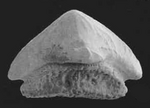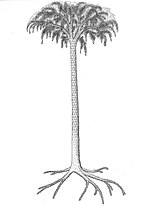Gharif Formation
| Gharif Formation | |
|---|---|
| Stratigraphic range: Permian | |
| Type | Geological formation |
| Unit of | Haushi Group |
| Sub-units |
|
| Underlies | Khuff Formation |
| Overlies | Al Khlata Formation |
| Thickness | 157 m (518.1 ft) |
| Location | |
| Coordinates | 55°31’00”E, 19°17’45”N[1] |
| Country | |
The Gharif Formation is a geologic formation in Oman. It preserves fossils dating back to the Permian period. The Gharif clastic reservoirs are an important hydrocarbon production unit, and the formation is a major producing oil and gas reservoir in Oman.[1][2][3]
Stratigraphy
The subsurface Gharif Formation has been informally divided into 3 members (Lower, Middle and Upper) by geologists from Petroleum Development Oman. Though these members may be difficult to distinguish in certain localities due to rapid lateral facies changes, differential incision, salt movement or erosion, multiple studies have shown that these 3 members can be correlated on a regional scale.[1][3][4]
Lower Gharif Member
The lower member is about 65 m (214.5 ft) thick in north and central Oman. It has been split into 3 submembers:[1][3][4]
- Lower Gharif submember-1 unconformably overlies the Al Khlata Formation and is made up mostly of cross-bedded quartz sandstone. Locally, crinoid and brachiopod remains can be found. Though its thickness varies across central Oman, it is generally about 25 meter thick and does not exceed 30 meters.[1]
- Lower Gharif submember-2 (or the Maximum Flooding Shale) contains bioturbated lime-mudstones and is under 10 meters thick.[1][3]
- Lower Gharif submember-3 (also known as the Haushi Limestone) is about 35 meters thick and occurs in much of central and north Oman. It is a cross-bedded oolitic packstone and grainstone, and stromatolitic mudstone.[1]
Middle Gharif Member
The middle member is about 85 m (280.5 ft) thick in north and Central Oman. It contains the following 3 informal units (from the base up):[1][3]
- Middle Gharif unit 1 is less than 10 meters thick and represents shoreface, tidal flat, lagoonal and mixed paralic environments.[1]
- Middle Gharif unit 2 is under 40 meters thick. Deposited after the demise of the 'Haushi Sea' in an episodically dry environment, it exhibits interlocking marine and non-marine conditions, representing major progradation and coastal advance.[1]
- Middle Gharif unit 3 (occasionally inappropriately referred to as the Playa Shale) is made up of a red-brown Shale and is over 40 meters thick. Though suggested to represent an extensive intracratonic ephemeral lake system, it has been reinterpreted to be laid down during a long dry period which caused significant pedified palaeosol horizon development.[1][3]
Upper Gharif Member
The upper member is about 90 m (295 ft) thick in north and central Oman. Informally, it has been split into the ‘Upper Gharif Sandstone’ and ‘Upper Gharif Red Beds’.[1][3]
Fossil content
Amphibians
| Amphibians reported from the Gharif Formation | ||||||
|---|---|---|---|---|---|---|
| Genus | Species | Locality | Stratigraphic member | Material | Notes | Images |
| Aistopoda? | Indeterminate | Al Wusta Region.[5] | Middle Gharif.[5] | A vertebra.[5] | Potential aistopod fossil. | |
| Lepospondyli | Indeterminate | Al Wusta Region.[5] | Middle Gharif.[5] | Tooth plate.[5] | A lepospondyl. | |
Fish
Acanthodians
| Acanthodians reported from the Gharif Formation | ||||||
|---|---|---|---|---|---|---|
| Genus | Species | Locality | Stratigraphic member | Material | Notes | Images |
| Acanthodii | Indeterminate | Al Wusta Region.[5] | Middle Gharif.[5] | Scales.[5] | Undeterminable acanthodian remains. | |
Bony fish
| Bony fish reported from the Gharif Formation | ||||||
|---|---|---|---|---|---|---|
| Genus | Species | Locality | Stratigraphic member | Material | Notes | Images |
| Gnathorhiza | G. sp. | Al Wusta Region.[5][6] | Middle Gharif.[5][6] | Vomer & pterygoid.[5] | A lungfish. |  |
| Palaeoniscoidei | Indeterminate | Al Wusta Region.[5] | Middle Gharif.[5] | Scales.[5] | Undeterminable palaeoniscoid remains. | |
Cartilaginous fish
| Cartilaginous fish reported from the Gharif Formation | ||||||
|---|---|---|---|---|---|---|
| Genus | Species | Locality | Stratigraphic member | Material | Notes | Images |
| Lissodus | L. sp. | Al Wusta Region.[5] | Middle Gharif.[5] | A tooth.[5] | A hybodont. |  |
| Triodus | T. sp. | Al Wusta Region.[5] | Middle Gharif.[5] | Isolated teeth.[5] | A xenacanth. |  |
| Wurdigneria | W. sp. | Al Wusta Region.[5] | Middle Gharif.[5] | Isolated teeth.[5] | A xenacanth. | |
Invertebrates
| Invertebrates reported from the Gharif Formation | ||||||
|---|---|---|---|---|---|---|
| Genus | Species | Locality | Stratigraphic member | Material | Notes | Images |
| Conchostraca | Al Wusta Region.[5] | Middle Gharif.[5] | A clam shrimp. | |||
| "Spirorbis" | Al Wusta Region.[5] | Middle Gharif.[5] | A spirorbiform microconchid. | |||
Plants
| Plants reported from the Gharif Formation | ||||||
|---|---|---|---|---|---|---|
| Genus | Species | Locality | Stratigraphic member | Material | Notes | Images |
| Arberia | A. sp. | Huqf area.[7] | Isolated fertile structure.[7] | A glossopteridale. | ||
| Arberiopsis | A. sp. | Huqf area.[7] | Isolated fertile structure.[7] | A glossopteridale. | ||
| Baieroxylon | B. implexum | Huqf area.[7][8] | Wood.[7][8] | A ginkgoale. | ||
| Calamites | C. gigas | Huqf area.[7] | Medullar casts.[7] | A horsetail. |  | |
| Calamostachys | C. dumasii | Huqf area.[7] | Medullar casts.[7] | A horsetail. |  | |
| Cathaysiopteris | C. whitei | Huqf area.[7] | Leaves.[7] | A gigantopterid. | ||
| Comia | C. sp. | Huqf area.[7] | Leaves.[7] | A probable seed plant. | ||
| Cyclodendron | C. leslii | Huqf area.[7] | A lepidodendrale. | |||
| Dadoxylon (Eristophyton) | D. (E.) callixyloides | Huqf area.[7][8] | Wood.[7][8] | A conifer, represents a new species. | ||
| Gigantonoclea | G. lagrelii | Huqf area.[7] | Leaves.[7] | A gigantopterid. | ||
| G. sp. | Huqf area.[7] | A gigantopterid. | ||||
| Gigantopteris | G. sp. | Huqf area.[7] | Leaves.[7] | A gigantopterid. | ||
| Glossopteris | G. angustifolia | Huqf area.[7] | Leaves.[7] | A glossopteridale. |  | |
| G. browniana | Huqf area.[7] | A glossopteridale. |  | |||
| G. claramarginata | Huqf area.[7] | A glossopteridale. | ||||
| G. damudica | Huqf area.[7] | A glossopteridale. | ||||
| G. occidentalis | Huqf area.[7] | A glossopteridale. | ||||
| G. taeniopteroides | Huqf area.[7] | A glossopteridale. | ||||
| Lanceolatus | L. sp. | Huqf area.[7] | Female organs.[7] | A glossopteridale. | ||
| Lepidodendron | L. acutangula | Huqf area.[7] | Stems.[7] | A lepidodendrale. |  | |
| Lidgettonia | L. sp. | Huqf area.[7] | A glossopteridale. | |||
| Otovicia (Walchia) | O. (W.) hypnoides | Huqf area.[7] | A conifer. |  | ||
| Plumsteadia | P. sp. | Huqf area.[7] | Female organs.[7] | A glossopteridale. | ||
| Prototaxoxylon | P. gharifense | Huqf area.[7][8] | Wood.[7][8] | |||
| Sigillaria | S. brardii | Huqf area.[7] | A lepidodendrale. |  | ||
| Sphenophyllum | S. speciosum | Huqf area.[7] | Macrofossils.[7] | A sphenophyllale. |  | |
| S. sino-coreanum | Huqf area.[7] | Macrofossils.[7] | A sphenophyllale. |  | ||
| Tingia | T. sp. | Huqf area.[7] | Leaves.[7] | A noeggerathiale. | ||
| Tingiostachya | T. sp. | Huqf area.[7] | Fertile cones.[7] | A noeggerathiale. | ||
| Trigonomyelon | T. omanense | Huqf area.[7][8] | Wood.[7][8] | A probable conifer. | ||
See also
References
- ^ a b c d e f g h i j k l Osterloff, Peter; Al-Harthy, Aida; Penney, Randall; Spaak, Pieter; Williams, Glen; Al-Zadjali, Farida; Jones, Neil; Knox, Robert; Stephenson, Michael; Oliver, Guy; Al-Husseini, Moujahed (January 2004). "Depositional sequences of the Gharif and Khuff Formations, subsurface Interior Oman". GeoArabia: 83–147.
- ^ Alsop, D. B.; Al Ghammari, M.; Al Abri, A.; Al Mahrooqi, A.; Al Rawahi, H.; Salem, H. (2013-10-17). "Reservoir architecture of the Gharif Formation outcrops in the Southern Huqf area, Sultanate of Oman". Geological Society, London, Special Publications. 387 (1): 111–133. doi:10.1144/sp387.8. ISSN 0305-8719.
- ^ a b c d e f g Fer Guit, Mohamed Al-Lawati, Peter (1995). "Seeking New Potential in the Early-Late Permian Gharif Play, West Central Oman: ABSTRACT". AAPG Bulletin. 79. doi:10.1306/8D2B2899-171E-11D7-8645000102C1865D. ISSN 0149-1423. S2CID 131601681.
{{cite journal}}: CS1 maint: multiple names: authors list (link) - ^ a b Blendinger, W.; van Vliet, A.; Hughes Clarke, M. W. (January 1990). "Updoming, rifting and continental margin development during the Late Palaeozoic in northern Oman". Geological Society, London, Special Publications. 49 (1): 27–37. doi:10.1144/gsl.sp.1992.049.01.03. ISSN 0305-8719.
- ^ a b c d e f g h i j k l m n o p q r s t u v w x y z aa ab Schultze, Hans-Peter; Soler-Gijon, Rodrigo; Hampe, Oliver; Heward, Alan (July 2008). "Vertebrates from the Gharif Formation, Lower Permian, of Oman". Faunas and Palaeoenvironments of the Late Palaeozoic. Special Publication of 5th Symposium on Permo-Carboniferous Faunas: 41–42.
- ^ a b Skrzycki, P. (2016-01-15). "The westernmost occurrence of Gnathorhiza in the Triassic, with a discussion of the stratigraphic and palaeogeographic distribution of the genus". Fossil Record. 19 (1): 17–29. doi:10.5194/fr-19-17-2016. ISSN 2193-0074.
- ^ a b c d e f g h i j k l m n o p q r s t u v w x y z aa ab ac ad ae af ag ah ai aj ak al am an ao ap aq ar as at au av aw ax Berthelin, M.; Broutin, J.; Kerp, H.; Crasquin-Soleau, S.; Platel, J.-P.; Roger, J. (July 2003). "The Oman Gharif mixed paleoflora: a useful tool for testing Permian Pangea reconstructions". Palaeogeography, Palaeoclimatology, Palaeoecology. 196 (1–2): 85–98. doi:10.1016/S0031-0182(03)00314-6.
- ^ a b c d e f g h Berthelin, M.; Vonzenin-Serra, C.; Broutin, Jean (November 2004). "Phytogeographic and climatic implications of Permian woods discovered in Oman (Arabian Peninsula)". Palaeontographica Abteilung B. 268: 4–6.
- Various Contributors to the Paleobiology Database. "Fossilworks: Gateway to the Paleobiology Database". Retrieved 29 July 2023.

